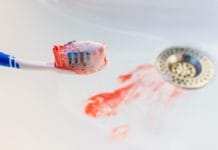Disclosure: This article is sponsored content from Septodont as part of our sponsored partner program.
Pain management is arguably one of the most important aspects of patient care. Poor pain management can lead to dental fear and anxiety that could ultimately delay treatment, increase costs, and require more invasive treatments. First introduced in the 1900s, local anesthetic is the most used, most effective, and safest way to manage dental pain.1
Local anesthetic in the form of cocaine was first used in 1859 for ophthalmic surgery. However, as you can imagine, many adverse events led to the need to develop a safer alternative. In 1905, procaine was developed and used for over 40 years before other local anesthetics were developed. Lidocaine was marketed in 1948, followed by mepivacaine (1957), prilocaine (1960), bupivacaine (1963), and articaine (1975).1 Interestingly, though articaine has been used since 1975 in Europe, it wasn’t approved for use in the U.S. until April 3, 2000.2
Articaine versus Lidocaine: Benefits and Superiority
A meta-analysis published in 2010 found that articaine had a higher rate of anesthetic success with the same level of safety compared to lidocaine for infiltration and blocks.3 The chemical structure of articaine allows for increased liposolubility, which permits the anesthetic to diffuse through the nerve cell lipid membrane and into surrounding tissue effectively.3
In addition, the concentration is higher at 4% versus 2% in lidocaine. This means you can potentially use less anesthetic solution to achieve the same level of anesthesia. Due to the higher concentration, the maximum recommended dose of articaine is seven cartridges versus 13 for lidocaine.3
A meta-analysis published in 2021 found articaine was superior in reaching anesthetic success compared to lidocaine. Articaine was found to be 1.5 times more successful than lidocaine for mandibular blocks and 2.78 times more successful than lidocaine in both maxillary and mandibular infiltrations.4
Further studies have looked at pulpal anesthesia onset as well as duration. The mean pulpal onset time was significantly better with articaine 1:100,000 versus lidocaine 1:100,000, with the duration of pulpal anesthesia being 61 minutes for lidocaine 1:100,000 and 106 minutes for articaine 1:100,000. Articaine was found to be significantly better in terms of complete anesthesia and duration, which is a time saver in clinical practice on both accounts.5
Safety of Articaine
To better understand articaine’s safety, understanding the elimination half-life is necessary. Elimination half-life is not the same as duration. Elimination half-life is defined as “the length of time required for the concentration of a particular substance (typically a drug) to decrease to half of its starting dose in the body.”6
The molecular structure of articaine sets it apart from other local anesthetics and contributes to its impressive safety profile. Articaine has a thiophene ring and an ester side chain allowing it to be quickly metabolized systemically by inactivation through hydrolysis of the ester side chain. Other local anesthetics are metabolized primarily in the liver, whereas 90% of articaine is metabolized via hydrolysis of the ester side chain in the plasma and excreted via the kidneys. The remaining 10% is metabolized in the liver. Therefore, articaine has the shortest elimination half-life of all local anesthetics. For comparison, articaine’s elimination half-life is around 27-42 minutes, while lidocaine’s elimination half-life is 90 minutes. This contributes to the assertion that articaine is less toxic than lidocaine.3,5,7
In a randomized controlled trial aiming to assess the safety and efficacy of articaine in third molar extractions, the study found the use of articaine led to fewer re-injections to complete the extractions painlessly.8 Administering fewer injections decreases the risk of accidentally causing nerve damage, and patient comfort is improved because fewer injections will likely reduce post-injection site pain.
Paresthesia
The biggest concern often raised by dental professionals is the risk of paresthesia which was attributed to articaine in a retrospective study published many years ago. Since that study was published, multiple prospective studies have attempted to reach the same conclusion and have failed to do so. One such study suggested it was likely the injection technique of the clinician that caused the paresthesia and not the neurotoxicity or concentration of the anesthetic.9
One such randomized double-blinded clinical trial looking to compare efficacy and safety between articaine and lidocaine found that paresthesia occurred at the same rate in both the articaine group and the lidocaine group (1%). This prospective clinical trial further supports the assertion that articaine does not have a higher risk of paresthesia when compared with other local anesthetics.10
An in vitro study has shown that articaine is less cytotoxic than lidocaine. This study grouped local anesthetics into three groups regarding toxicity: 1) less toxic (ropivacaine and articaine), 2) medium level of toxicity (mepivacaine, prilocaine, and lidocaine), and 3) high level of toxicity (bupivacaine). The study goes on to conclude that their findings suggest articaine is the least neurotoxic of all the local anesthetics included in the study (in SH-SY5Y cells in vitro). This is an important study as many postulate the reason for paresthesia is associated with the neurotoxic effects of the local anesthetic.11
Safety in Pediatric Patients
The safety of articaine in pediatric patients has been well established. In a retrospective study published over 30 years ago, in 1989, the authors determined articaine was safe to use in children under the age of 4. In a more recent review published in 2011, the authors found articaine was safe and efficacious in children of all ages. Furthermore, a study published in 2018 found no difference between lidocaine and articaine regarding adverse events in children.5
The manufacturer’s information regarding the use of articaine in children under the age of four is because children under the age of 4 were not included in the clinical trials. However, since then, multiple studies have supported the use of articaine in children under the age of four, citing that articaine has increased potency, reduced toxicity, lower dosage for sustained anesthesia, and low occurrence of adverse effects when compared to lidocaine.12
In Closing
Understanding the benefits, superiority, and safety profile of articaine compared to other local anesthetics should give dental professionals the confidence to implement articaine regularly as a safe and effective pain control measure. With quicker onset time, longer duration, and higher rates of success, the use of articaine should be a welcome alternative to previously utilized local anesthetics.
To learn more about Septodont’s formulation of articaine, Septocaine, click here.
References
- Singh P. An Emphasis on the Wide Usage and Important Role of Local Anesthesia in Dentistry: A Strategic Review. Dental Research Journal. 2012;9(2): 127-132. https://www.ncbi.nlm.nih.gov/pmc/articles/PMC3353686/
- Drug Approval Package: Septocaine (Articaine Hydrochloride w/Epinephrine) Injection. (2000, April 3). U.S. Food & Drug Administration. https://www.accessdata.fda.gov/drugsatfda_docs/nda/2000/020971_SeptocaineTOC.cfm
- Katyal, V. The Efficacy and Safety of Articaine versus Lignocaine in Dental Treatments: A Meta-analysis. Journal of Dentistry. 2010; 38(4): 307-317. https://doi.org/10.1016/j.jdent.2009.12.003 https://pubmed.ncbi.nlm.nih.gov/20006669/
- Martin, E., Nimmo, A., Lee, A., Jennings, E. Articaine in Dentistry: An Overview of the Evidence and Meta-analysis of the Latest Randomised Controlled Trials on Articaine Safety and Efficacy Compared to Lidocaine for Routine Dental Treatment. BDJ Open. 2021;7: 27. https://doi.org/10.1038/s41405-021-00082-5
- Tortamano, I.P., Siviero, M., Lee, S., et al. Onset and Duration Period of Pulpal Anesthesia of Articaine and Lidocaine in Inferior Alveolar Nerve Block. Brazilian Dental Journal. 2013;24(4): 371-374. https://doi.org/10.1590/0103-6440201302072
- Hallare, J., Gerriets, V. (2022, June 23). Half Life. StatPearls https://www.ncbi.nlm.nih.gov/books/NBK554498/
- Luo, W., Zheng, K., Kuang, H., et al. The Potential of Articaine as New Generation of Local Anesthesia in Dental Clinics: A Review. Medicine. 2022; 101(48): e32089. https://journals.lww.com/md-journal/Fulltext/2022/12020/The_potential_of_articaine_as_new_generation_of.18.aspx
- Santos-Sanz, L., Toledano-Serrabona, J., Gay-Escoda, C. Safety and Efficacy of 4% Articaine in Mandibular Third-molar Extraction: A Systematic Review and Meta-analysis of Randomized Clinical Trials. Journal of the American Dental Association. 2020;151(12): 912-923.e10. https://doi.org/10.1016/j.adaj.2020.08.016
- Ahmad, M. The Anatomical Nature of Dental Paresthesia: A Quick Review. The Open Dentistry Journal. 2018; 12: 155-159. https://doi.org/10.2174/1874210601812010155
- Malamed, S.F., Gagnon, S., Leblanc, D. Articaine Hydrochloride: A Study of the Safety of a New Amide Local Anesthetic. Journal of the American Dental Association. 2001; 132(2): 177-185. https://doi.org/10.14219/jada.archive.2001.0152
- Malet, A., Faure, M.O., Deletage, N., et al. The Comparative Cytotoxic Effects of Different Local Anesthetics on a Human Neuroblastoma Cell Line. Anesthesia and Analgesia. 2015;120(3): 589-596. https://doi.org/10.1213/ANE.0000000000000562
- Ezzeldin, M., Hanks, G., Collard, M. United Kingdom Pediatric Dentistry Specialist Views on the Administration of Articaine in Children. Journal of Dental Anesthesia and Pain Medicine. 2020;20(5): 303-312. https://doi.org/10.17245/jdapm.2020.20.5.303












